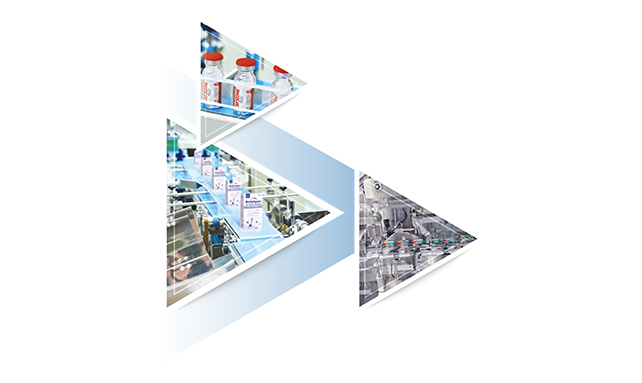

More than 200 Distributors
Around 1,000,000 Outlets
Nationwide Coverage
Cilapen
(Imipenem/Cilastatin)
Brand Name
Cilapen
Generic Name
(Imipenem/Cilastatin)
Therapeutic Segment
Antibiotic (Carbapenem)

Scan QR code to open on your mobile device.
Available as
- INJECTION
- CILAPEN 250MG INJECTION
- CILAPEN 500MG INJECTION
PRESCRIBING INFORMATION
(Summary of product characteristics)
QUALITATIVE AND QUANTITATIVE COMPOSITION
Cilapen 250
Sterile Powder for Injection 250mg + 250mg
Each vial contains:
Imipenem USP ….. 250mg as Imipenem Monohydrate
Cilastatin …. 250mg as Cilastatin Sodium USP
(Product Specs.: USP)
Contains Sodium bicarbonate
Cilapen 500
Sterile Powder for Injection 500mg + 500mg
Each vial contains:
Imipenem USP ….. 500mg as Imipenem Monohydrate
Cilastatin …. 500mg as Cilastatin Sodium USP
(Product Specs.: USP)
Contains Sodium bicarbonate
PHARMACEUTICAL FORM
Sterile powder for Injection
CLINICAL PARTICULARS
THERAPEUTIC INDICATIONS
CILAPEN is indicated for the treatment of the following infections in adults and children
1 year of age and above:
- Severe pneumonia including hospital and ventilator-associated pneumonia
- Complicated intra-abdominal infections
- Intra and post-partum infections
- Complicated urinary tract infections
- Complicated skin and skin structure, bone and soft-tissue infections
- Neutropenic patients with fever that is suspected to be due to a bacterial infection.
- Treatment of patients with bacteremia that occurs in association with, or is suspected to be associated with, any of the infections listed above.
POSOLOGY AND METHOD OF ADMINISTRATION
Posology: The dose recommendations for CILAPEN represent the quantity of imipenem and cilastatin to be administered.
The daily dose should be based on the type of infection and given in equally divided doses based on consideration of degree of susceptibility of the pathogen(s) and the patient’s renal function.
Adults and adolescents
For patients with normal renal function (creatinine clearance of ≥90 mL/min), the recommended dose regimens are 500mg/500mg every 6 hours OR 1000mg/1000mg every 8 hours OR every 6 hours.
It is recommended that infections suspected or proven to be due to less susceptible bacterial species (such as Pseudomonas aeruginosa) and very severe infections (e.g., in neutropenic patients with a fever) should be treated with 1000mg/1000mg administered every 6 hours.
A reduction in dose is necessary when creatinine clearance is < 90 mL/min. The maximum total daily dose should not exceed 4000mg/4000mg per day.
Renal impairment
To determine the reduced dose for adults with impaired renal function: The total daily dose (i.e., 2000/2000mg, 3000/3000mg or 4000/4000mg) that would usually be applicable to patients with normal renal function should be selected.
|
Creatinine clearance (mL/min) is: |
If TOTAL DAILY DOSE is: 2000mg/day |
If TOTAL DAILY DOSE is: 3000mg/day |
If TOTAL DAILY DOSE is: 4000mg/day |
|
≥90 (normal) |
500 q6h |
1000 q8h |
1000 q6h |
|
reduced dosage (mg) for patients with renal impairment: |
|||
|
<90 – ≥60 |
400 q6h |
500 q6h |
750 q8h |
|
<60 – ≥30 |
300 q6h |
500 q8h |
500 q6h |
|
<30 – ≥15 |
200 q6h |
500 q12h |
500 q12h |
Patients with a creatinine clearance of <15 mL/min: should not receive unless hemodialysis is instituted within 48 hours.
Patients on hemodialysis: Both imipenem and cilastatin are cleared from the circulation during hemodialysis. The patient should receive after hemodialysis and at 12-hour intervals timed from the end of that hemodialysis session.
Hepatic impairment: No dose adjustment in patients with impaired hepatic function.
Elderly population: No dose adjustment is required for the elderly patients with normal renal function.
Pediatric population: For pediatric patient’s ≥1 year of age, the recommended dose is 15/15 or 25/25mg/kg/dose administered every 6 hours.
Method of administration
- CILAPEN is to be reconstituted and further diluted prior to administration.
- Each dose of ≤500mg/500mg should be given by intravenous infusion over 20 to 30 minutes.
- Each dose >500mg/500mg should be infused over 40 to 60 minutes. In patients who develop nausea during the infusion, the rate of infusion may be slowed.
Reconstitution:
Contents of each vial must be transferred to 100 mL of an appropriate infusion solution 0.9% sodium chloride. In exceptional circumstances where 0.9% sodium chloride cannot be used for clinical reasons 5% glucose may be used instead.
A suggested procedure is to add approximately 10 mL of the appropriate infusion solution or 10mL WFI to the vial. Shake well and transfer the resulting mixture to the infusion solution container.
CAUTION: THE MIXTURE IS NOT FOR DIRECT INFUSION.
- Repeat with an additional 10 mL of infusion solution to ensure complete transfer of vial contents to the infusion solution. The resulting mixture should be agitated until clear.
- The concentration of the reconstituted solution following the above procedure is approximately 5mg/mL for both imipenem and cilastatin.
Contraindications
- Hypersensitivity to the active substances
- Hypersensitivity to any other carbapenem antibacterial agents (e.g., penicillins or cephalosporins).
- Severe hypersensitivity (e.g., anaphylactic reaction, severe skin reaction) to any other type of beta-lactam antibacterial agent (e.g., penicillins or cephalosporins).
Special warnings and precautions for use
Hypersensitivity
Before initiating therapy with Imipenem and cilastatin, careful inquiry should be made concerning previous hypersensitivity reactions to carbapenems, penicillins, cephalosporins, other beta-lactams and other allergens. If an allergic reaction to Imipenem and cilastatin occurs, discontinue the therapy immediately.
Serious anaphylactic reactions require immediate emergency treatment.
Hepatic: Hepatic Function should be closely monitored during treatment with imipenem and cilastatin due to the risk of hepatic toxicity (such as increase in transaminases, hepatic failure and fulminant hepatitis).
Hematology: A positive direct or indirect Coombs test may develop during treatment with imipenem and cilastatin.
Antibacterial spectrum: Concomitant use of an anti-MRSA agent may be indicated when Pseudomonas aeruginosa infections are suspected or proven to be involved in the approved indications.
Interaction with valproic acid: The concomitant use of imipenem and cilastatin and valproic acid/sodium valproate is not recommended.
Clostridioides difficile: Antibiotic-associated colitis and pseudomembranous colitis have been reported with imipenem and cilastatin. Discontinuation of therapy with imipenem and cilastatin and the administration of specific treatment for Clostridioides difficile should be considered. Medicinal products that inhibit peristalsis should not be given.
Meningitis: Imipenem and cilastatin is not recommended for the therapy of meningitis.
Renal impairment: Imipenem and cilastatin accumulates in patients with reduced kidney function. CNS adverse reactions may occur if the dose is not adjusted to the renal function.
Central nervous system: Adverse reactions such as myoclonic activity, confusional states, or seizures have been reported in patients with CNS disorders (e.g., brain lesions or history of seizures) and/or compromised renal function in whom accumulation of the administered entities could occur. Hence close adherence to recommended dose schedules is urged especially in these patients.
Patients with creatinine clearances of <15 mL/min should not receive Imipenem and cilastatin unless hemodialysis is instituted within 48 hours. For patients on hemodialysis, Imipenem and cilastatin is recommended only when the benefit outweighs the potential risk of seizures.
Sodium:
Imipenem and Cilastatin 250mg+250mg contains 0.8mmol (18.8mg) sodium per dose.
Imipenem and Cilastatin 500mg+500mg contains 1.6mmol (37.5mg) sodium per dose.
This should be taken into consideration by patients on a controlled sodium diet.
Interaction with other medicinal products and other forms of interaction
Ganciclovir: Generalized seizures have been reported in patients who received ganciclovir and Imipenem and cilastatin. It should not be used concomitantly unless the potential benefit outweighs the risks.
Valproic acid: Decreases in valproic acid levels have been reported when co-administered with carbapenem agents. Concomitant use of imipenem and valproic acid/sodium valproate is not recommended.
Oral anti-coagulants: Simultaneous administration of antibiotics with warfarin may augment its anti-coagulant effects.
Concomitant administration of imipenem and cilastatin and probenecid: Resulted in minimal increases in the plasma levels and plasma half-life of imipenem and doubled the plasma level and half-life of cilastatin, the urinary recovery of active (non-metabolized) imipenem decreased to approximately 60% of the dose but had no effect on urine
recovery of cilastatin.
Pediatric population: Interaction studies have only been performed in adults.
Fertility, pregnancy and lactation
Pregnancy: Imipenem and cilastatin should only be used during pregnancy if the potential benefit outweighs the potential risk.
Lactation: Imipenem and cilastatin are excreted into the mother’s milk in small quantities. If the use of Imipenem and cilastatin is deemed necessary, the benefit of breast feeding for the child should be weighed against the possible risk for the child.
Fertility: There are no data available regarding potential effects of imipenem and cilastatin treatment on male or female fertility.
Effects on ability to drive and use machines
No studies on the effects on the ability to drive and use machines have been performed.
Undesirable effects
All adverse reactions are listed under system organ class and frequency: Very common (≥1/10), Common (≥1/100 to <1/10), Uncommon (≥1/1,000 to <1/100), Rare (≥1/10,000 to <1/1,000), Very rare (<1/10,000) and not known (cannot be estimated from the available data).
Within each frequency grouping, undesirable effects are presented in order of decreasing seriousness.
|
System Organ Class |
Frequency |
Event |
|
Infections and infestations |
Rare |
Pseudomembranous colitis, candidiasis |
|
Very rare |
Gastro-enteritis |
|
|
Blood and lymphatic system disorders |
Common |
Eosinophilia, thrombophlebitis |
|
Uncommon |
Pancytopenia, neutropenia, leucopenia, thrombocytopenia, thrombocytosis, hypotension and flushing. |
|
|
Rare |
Agranulocytosis |
|
|
Very rare |
Hemolytic anemia, bone marrow depression |
|
|
Immune system disorders |
Rare |
Anaphylactic reactions |
|
Psychiatric disorders |
Uncommon |
Psychic disturbances including hallucinations and confusional states |
|
Nervous system disorders |
Uncommon |
Seizures, myoclonic activity, dizziness, somnolence |
|
Rare |
Encephalopathy, paresthesia, focal tremor, taste perversion |
|
|
Very rare |
Aggravation of myasthenia gravis, headache |
|
|
Not known |
Agitation, dyskinesia |
|
|
Ear and labyrinth disorders |
Rare |
Hearing loss |
|
Very rare |
Vertigo, tinnitus |
|
|
Cardiac disorders |
Very rare |
Cyanosis, tachycardia, palpitations |
|
Vascular disorders |
Common |
Thrombophlebitis |
|
Uncommon |
Hypotension |
|
|
Very rare |
Flushing |
|
|
Respiratory, thoracic and mediastinal disorders |
Very rare |
Dyspnea, hyperventilation, pharyngeal pain |
|
Gastrointestinal disorders |
Common |
Diarrhea, vomiting, nausea |
|
Rare |
Staining of teeth and/or tongue |
|
|
Very rare |
Hemorrhagic colitis, abdominal pain, heartburn, glossitis, tongue papilla hypertrophy, increased salivation |
|
|
Hepatobiliary disorders |
Rare |
Hepatic failure, hepatitis |
|
Very rare |
Fulminant hepatitis |
|
|
Skin and subcutaneous tissue disorders |
Common |
Rash (e.g.,exanthematous) |
|
Uncommon |
Urticaria, pruritus |
|
|
Rare |
Toxic epidermal necrolysis, angioedema, Stevens-Johnson syndrome, erythema multiforme, exfoliative dermatitis |
|
|
Very rare |
Hyperhidrosis, skin texture changes |
|
|
Musculoskeletal and connective tissue disorders |
Very rare |
Polyarthralgia, thoracic spine pain |
Pediatric population (≥3 months of age): The reported adverse reactions were consistent with those reported for adults.
Overdose
No specific information is available on treatment of overdose with Imipenem and cilastatin. It is hemodialyzable. However, usefulness of this procedure in the overdose setting is unknown.
PHARMACOLOGICAL PROPERTIES
PHARMACODYNAMIC PROPERTIES
Pharmacotherapeutic group: Antibacterials for systemic use, carbapenems.
ATC code: J01D H51
Mechanism of action
CILAPEN consists of two components: imipenem and cilastatin sodium in a 1:1 ratio by weight. Imipenem, also referred to as N-formimidoyl-thienamycin, is a semi-synthetic derivative of thienamycin, the parent compound produced by the filamentous bacterium Streptomyces cattleya.
Imipenem exerts its bactericidal activity by inhibiting bacterial cell wall synthesis in Gram-positive and Gram-negative bacteria through binding to penicillin-binding proteins (PBPs).
Cilastatin sodium is a competitive, reversible and specific inhibitor of dehydropeptidase-I, the renal enzyme which metabolizes and inactivates imipenem.
Microbiology:
Commonly susceptible species:
Gram-positive aerobes: Enterococcus faecalis, Staphylococcus aureus (Methicillin-susceptible) Staphylococcus coagulase negative (Methicillin-susceptible), Streptococcus agalactiae, Streptococcus pneumoniae, Streptococcus pyogenes and Streptococcus viridans group.
Gram-negative aerobes: Citrobacter freundii, Enterobacter cloacae, Escherichia coli, Haemophilus influenza, Klebsiella oxytoca, Klebsiella pneumoniae, Klebsiella aerogenes (formerly Enterobacter aerogens), Moraxella catarrhalis and Serratia marcescens.
Gram-positive anaerobes: Clostridium perfringens and Peptostreptococcus spp.
Gram-negative anaerobes: Bacteroides fragilis group, Fusobacterium spp, Porphyromonas asaccharolytica, Prevotella spp. and Veillonella spp.
Breakpoints
|
Organism Group |
Minimum Inhibitory Concentrations (mg/L) |
|
|
Susceptible ≤ |
Resistant > |
|
|
Enterobacterales, Acinetobacter spp. |
2 |
4 |
|
Enterobacterales (Morganella morganii, Proteus spp. and Providencia spp.) Pseudomonas spp. and Enterococcus spp. |
0.001 |
4 |
|
Staphylococcus spp. |
Inferred from cefoxitin |
susceptibility |
|
Streptococcus A, B, C, G |
Inferred from the benz |
ylpenicillin susceptibility |
|
Streptococcus pneumoniae, Viridans group streptococci Haemophilus influenza and Moraxalla catarrhalis |
2 |
2 |
|
Gram-positive anaerobes except Clostridioides difficile, Burkholderia pseudomallei, Gram-negative anaerobes and non-species related breakpoints |
2 |
4 |
PHARMACOKINETIC PROPERTIES
Imipenem
Absorption
Intravenous infusion of imipenem and cilastatin over 20 minutes resulted in peak plasma levels of imipenem ranging from 12 to 20 μg/mL for the 250mg/250mg dose, from 21 to 58 μg/mL for the 500mg/500mg dose, and from 41 to 83 μg/mL for the 1000mg/1000mg dose. The mean peak plasma levels of imipenem following the 250mg/250mg, 500mg/500mg, and 1000mg /1000mg doses were 17, 39, and 66 μg/mL, respectively.
At these doses, plasma levels of imipenem decline to below 1 μg/mL or less in four to six hours.
Distribution
The binding of imipenem to human serum proteins is approximately 20%.
Biotransformation
When administered alone, imipenem is metabolized in the kidneys by dehydropeptidase-I. Individual urinary recoveries ranged from 5 to 40%, with an average recovery of 15-20% in several studies.
Cilastatin is a specific inhibitor of dehydropeptidase-I enzyme and effectively inhibits metabolism of imipenem so that concomitant administration of imipenem and cilastatin allows therapeutic antibacterial levels of imipenem to be attained in both urine and plasma.
Elimination
The plasma half-life of imipenem was one hour. Approximately 70% of the administered antibiotic was recovered intact in the urine within ten hours, and no further urinary excretion of imipenem was detectable. Urine concentrations of imipenem exceeded 10 μg/mL for up to eight hours after a 500mg/500mg dose of imipenem and cilastatin. The remainder of the administered dose was recovered in the urine as antibacterially inactive metabolites, and fecal elimination of imipenem was essentially nil. No accumulation of imipenem in plasma or urine has been observed with regimens of imipenem, administered as frequently as every six hours, in patients with normal renal function.
Cilastatin
Absorption:
Peak plasma levels of cilastatin, following a 20-minute intravenous infusion of (Imipenem and Cilastatin), ranged from 21 to 26 μg/mL for the 250mg/250mg dose, from 21 to 55 μg/mL for the 500mg/500mg dose and from 56 to 88 μg/mL for the 1000mg/1000mg dose. The mean peak plasma levels of cilastatin following the 250mg/250mg, 500mg/500mg, and 1000mg/1000mg doses were 22, 42, and 72 μg/mL respectively.
Distribution:
The binding of cilastatin to human serum proteins is approximately 40%.
Biotransformation and elimination:
The plasma half-life of cilastatin is approximately one hour. Approximately 70-80% of the dose of cilastatin was recovered unchanged in the urine as cilastatin within 10 hours of administration of imipenem.
Pharmacokinetics in special populations
Renal insufficiency:
Dose adjustment is necessary for patients with impaired renal function.
Hepatic insufficiency:
No dose adjustment is recommended in patients with hepatic impairment.
Pediatric population:
The average clearance (CL) and volume of distribution (Vdss) for imipenem were approximately 45% higher in pediatric patients (3 months to 14 years) as compared to adults. The AUC for imipenem following administration of 15/15mg/kg per body weight of imipenem and cilastatin to pediatric patients was approximately 30%
higher than the exposure in adults receiving a 500mg/500mg dose. At the higher dose, the exposure following administration of 25/25mg/kg imipenem and cilastatin to children was 9% higher as compared to the exposure in adults receiving a 1000mg/1000mg dose.
Elderly:
In healthy elderly volunteers (65 to 75 years of age with normal renal function for their age), the pharmacokinetics of a single dose of imipenem and cilastatin 500mg/500mg administered intravenously over 20 minutes were consistent with those expected in subjects with slight renal impairment for which no dose alteration is
considered necessary. The mean plasma half-lives of imipenem and cilastatin were 91 ± 7.0 minutes and 69 ± 15 minutes, respectively.
PHARMACEUTICAL PARTICULARS
Incompatibilities
This medicinal product is chemically incompatible with lactate and should not be reconstituted in diluents containing lactate. However, it can be administered into an I.V. system through which a lactate solution is being infused.
Special precautions for disposal and other handling:
After reconstitution: Diluted solutions should be used immediately. The time interval between the beginning of reconstitution and the end of intravenous infusion should not exceed two hours.
Each vial is for single use only.
Variations of colour, from colourless to yellow, do not affect the potency of the product.
Any unused medicinal product or waste material should be disposed off in accordance with local requirements.
Shelf life:
2 years.
Storage
- Protect from heat, sunlight & moisture, store below 25°C.
- Do not freeze the reconstituted solution.
- Keep out of the reach of children.
- The expiration date refers to the product correctly stored at the required conditions.
- To be sold on the prescription of a registered medical practitioner only.
MARKETING AUTHORISATION HOLDER
Head Office:
Bosch Pharmaceuticals (Pvt.) Ltd.,
8, Modern Society, Tipu Sultan Road, Karachi-75350 (Pakistan).
Manufacturing Site:
Bosch Pharmaceuticals (Pvt.) Ltd.,
Plot No. 221-223, Sector 23, Korangi Industrial area, Karachi-Pakistan.
MARKETING AUTHORISATION NUMBER(S)
Cilapen 250mg+250mg Injection: 048490
Cilapen 500mg+500mg Injection: 048491
Presentation:
Cilapen 250mg+250mg Injection:
Pack of 1 vial plus 1 ampoule of 10mL sterile water for injection as solvent
Cilapen 500mg+500mg Injection:
Pack of 1 vial plus 1 ampoule of 10mL sterile water for injection as solvent
DATE OF FIRST AUTHORISATION/RENEWAL OF THE AUTHORISATION
09-02-2008 / 08-02-2023
DATE OF REVISION OF TEXT
25-10-2023

